We’ve got an extra cool Critter Corner for you this month to round out June! The sun is shining, the days are warmer, and the reptiles are out. This includes copperhead snakes!
We know copperhead snakes can bring out strong feelings for many people. Respect is all we ask for at RWS. You don’t need to be the copperhead snake’s #1 fan (though we are!). Rather, we just ask that folks respect them enough to leave them be. By highlighting copperhead snakes this month, we hope to help people better understand these important creatures and empower our human neighbors to coexist with our wild ones. Even if you’re squirming a bit at the thought of it, we politely ask that you read through the end for the sake of helping our native critters.
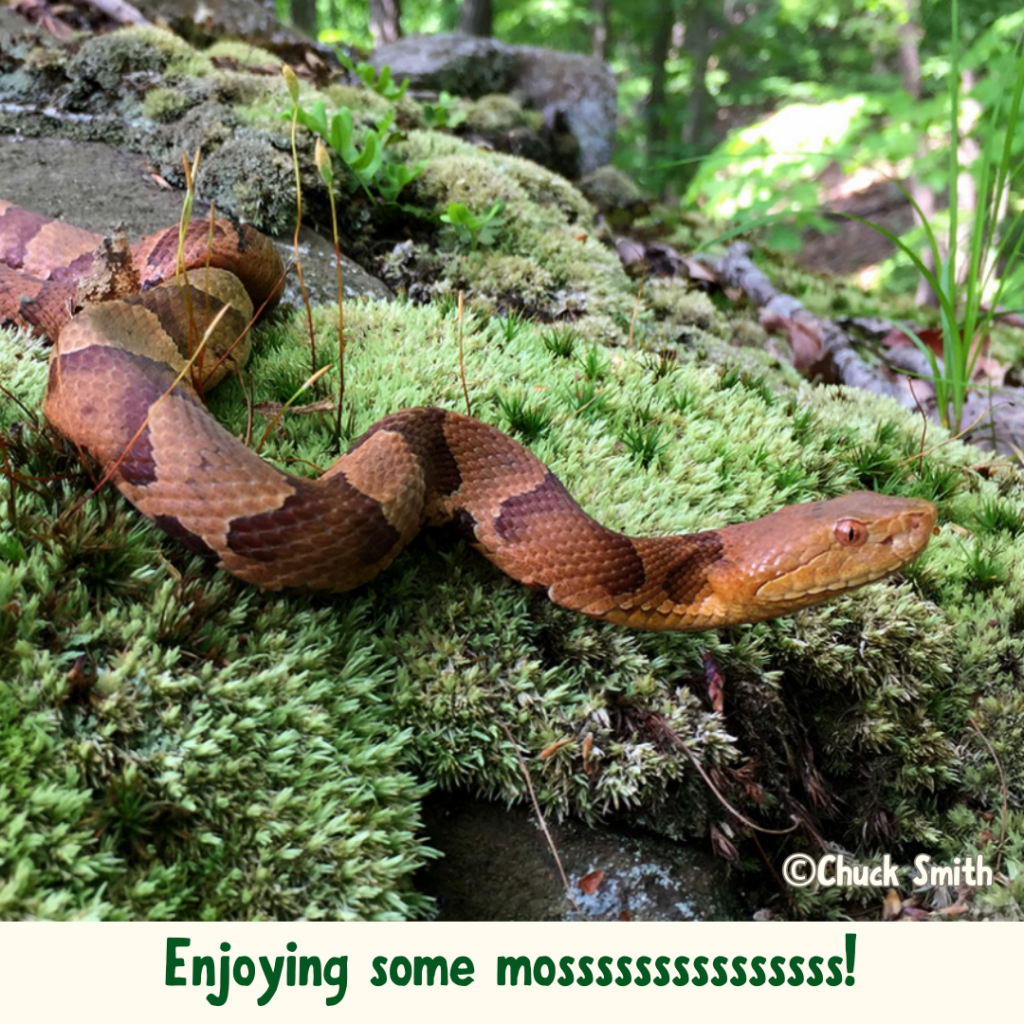
There are just three venomous species of snake in Virginia, of which the Eastern Copperhead snake (Agkistrodon contortrix, and formerly called the Northern Copperhead) is the most commonly spotted. Timber Rattlesnakes are state-endangered, appearing only in Virginia the western mountains and a sliver of the southeast. Northern Cottonmouth snakes are found only in the southeastern part of the state.
Keep in mind that none of these species are poisonous, which refers to plants and animals that are toxic to eat. You’re probably not eating snakes much – which makes sense, since as a non-game species, they’re protected! Venomous, on the other hand, refers to when an animal injects venom into you through a bite.
Let’s talk about the copperhead’s unique appearance. Copperhead snakes are usually two to three feet in length and relatively thick-bodied (occasionally downright chonky) snakes that live in a variety of habitats, from urban backyards to rural hills to riparian zones. They have keeled scales, meaning each scale has a small ridge going down the middle. This creates a rougher texture and may help with grip through grassy areas. Their shimmering coppery-color is interspersed with chestnut brown Hershey’s kiss patterns on their backside, enabling them to be Olympians when it comes to camouflaging. 🥇 Their wide, triangular heads and vertical pupils also contribute to their strikingly good looks. 💅
Too often, we have folks call us and say they want us to confirm identification of the copperhead they killed “just in case” – only to send us a picture of a mutilated garter snake or juvenile ratsnake instead. 😔 We do not advocate for cruelty in any case when it comes to wildlife, but knowing your snake ID can help empower you to feel safer in the outdoors! The Virginia Herpetological Society has an excellent resource page depicting commonly misidentified species, and we’ll share a couple here. Can you guess the species shown? Click on each image for a detailed look!
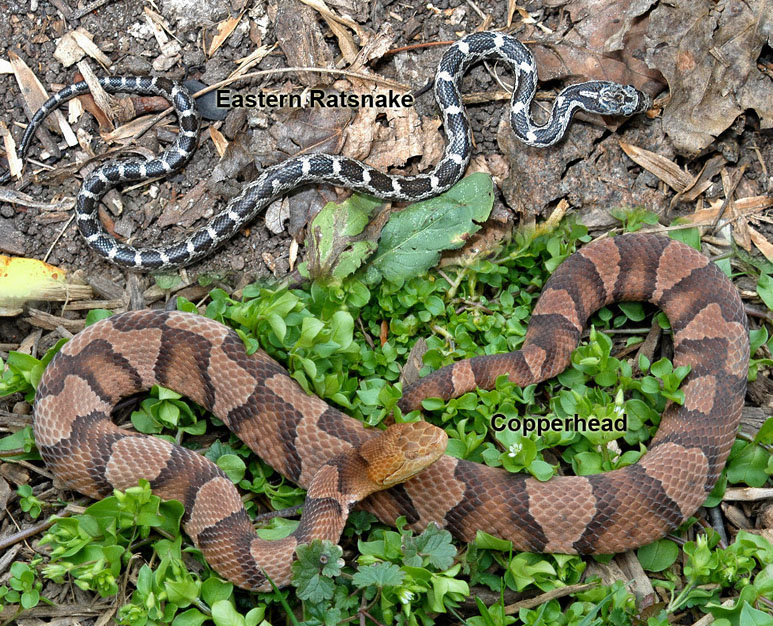
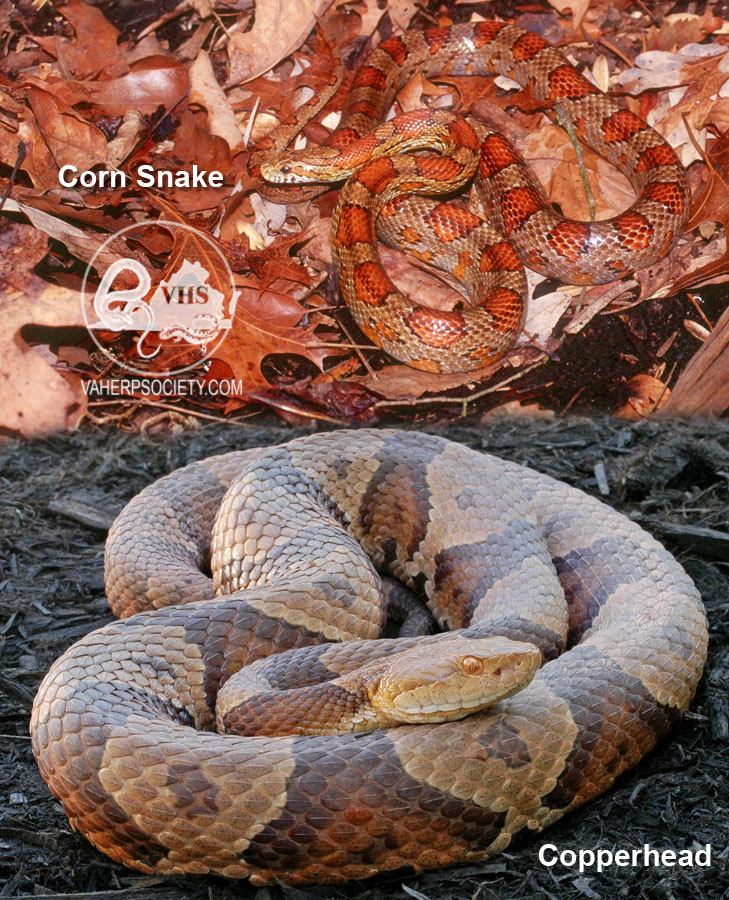
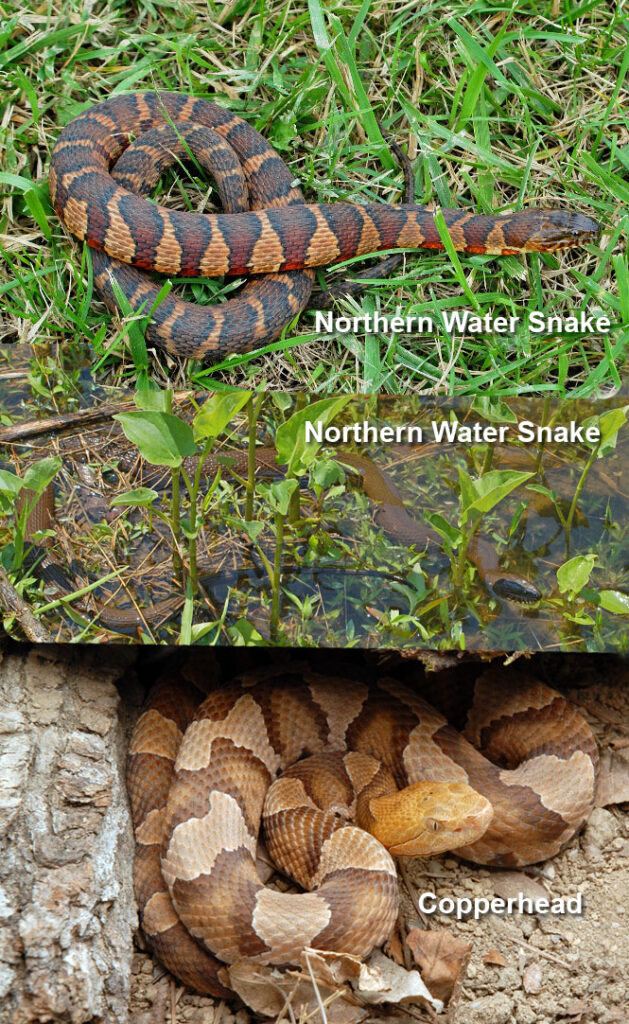
Perhaps surprising to many, copperhead snakes are a little more social compared to other herptiles. Like most Virginian reptiles, they brumate in the winter. Brumation is a reptile’s version of hibernation, and their metabolic processes slow down drastically to ensure they survive the colder months when food is scarce. Copperheads often brumate in communal dens, even sharing their dens with other species like eastern ratsnakes. Aw! These snakes typically return to the same den to snooze each year, which is quite charming if you ask us. During spring and summer, you might occasionally see a couple copperheads sunning themselves together. 🥲 Of course, a snake’s capacity for true camaraderie in the way we mammals think of it is more primitive, but studies showing snake “friendships” suggest that perhaps we’re underestimating these creatures when it comes to socialization.
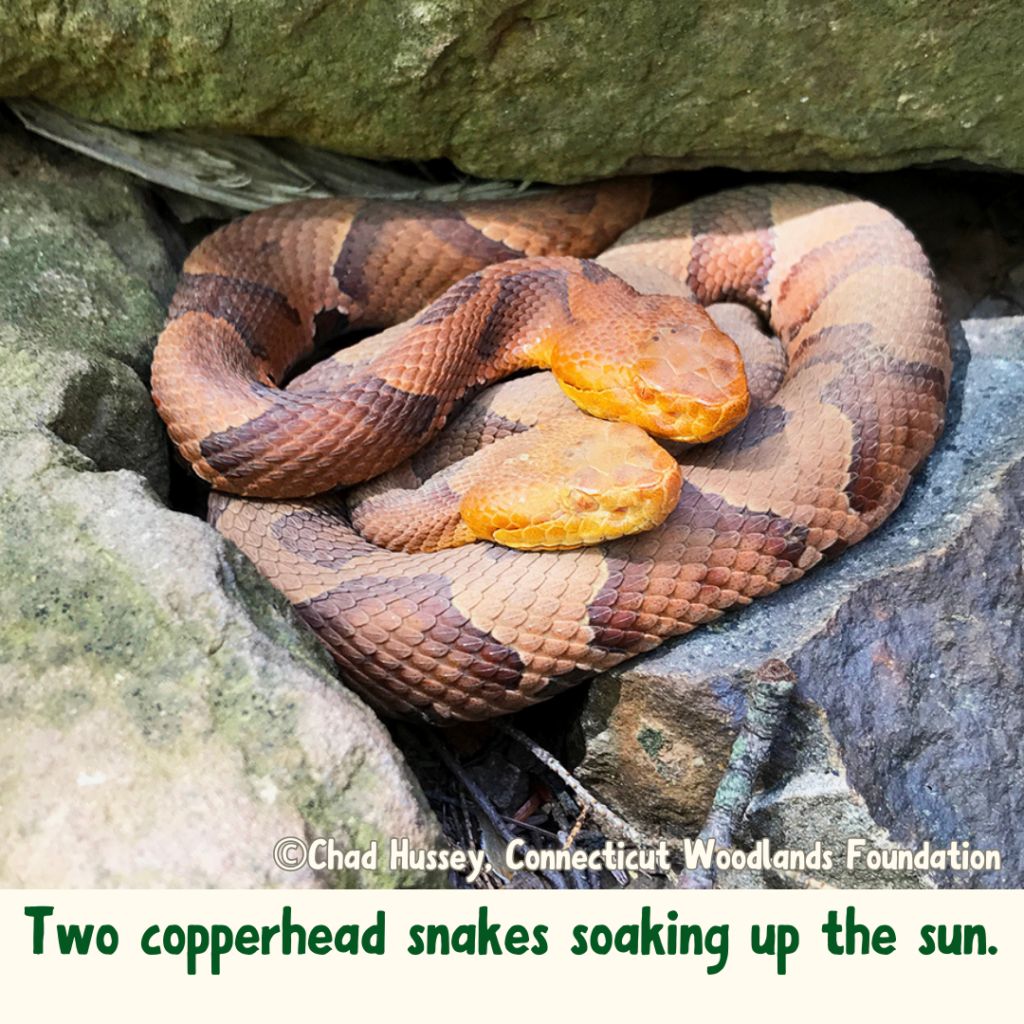
When it comes to eating, copperheads locate their prey using a very cool adaption. They have an open orifice, called a pit, between their nostril and eye on each side of their face. These pit organs sense heat and allow them to find their next meal even when it’s dark out. Copperhead snakes are mostly nocturnal in the summer, so this extra “night vision” helps them stay happy and full. 😋
Their forked tongue is also an important adaptation and not a symbol of being evil or demonic. They smell with their tongues, so having two separate tines they can control independently can help them sniff in a wider range simultaneously. 👃
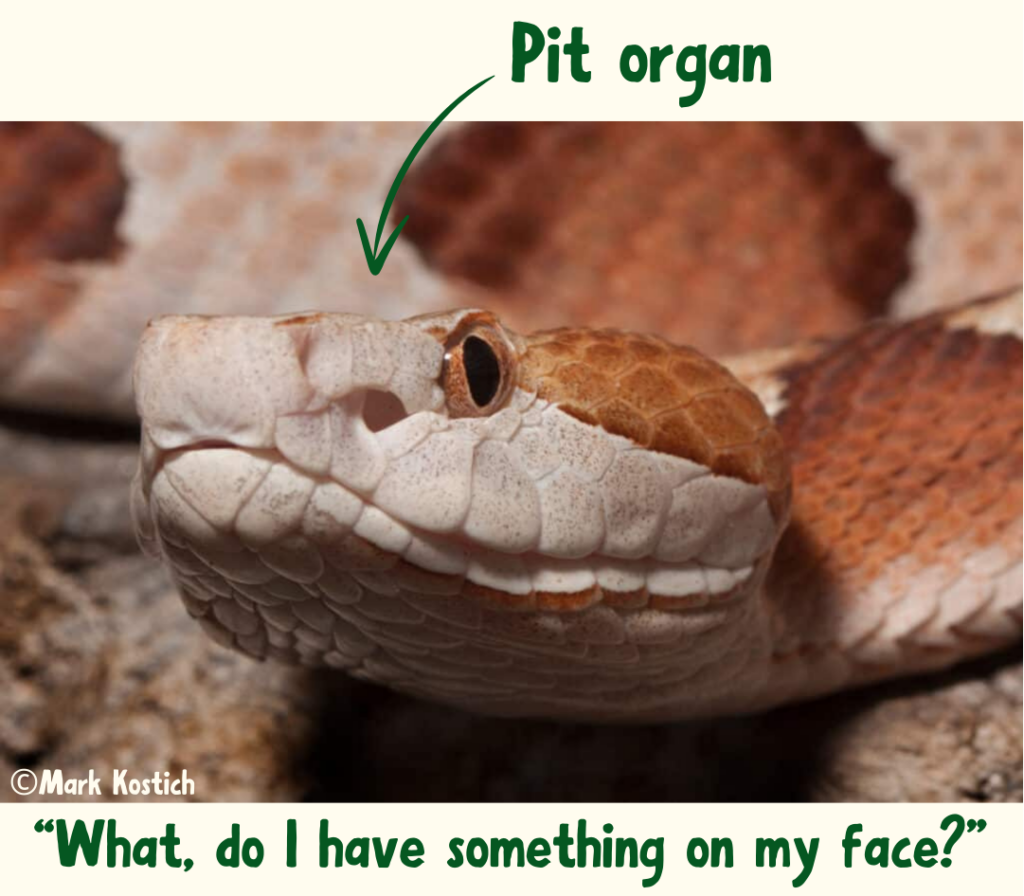
Copperheads are massively important to a healthy ecosystem, including a healthy backyard ecosystem. Yes, it’s true! A copperhead’s venom is hemolytic, meaning it breaks down red blood cells in their prey. This subdues the prey and allows them to more easily consume them. Their venom helps them catch a very wide variety of prey. While their primary prey is typically rodents, they’re also important in controlling bird, amphibian, and insect populations. (Humans are not prey for copperheads.) Young copperheads, born in late summer and early fall, use their bright yellow tails as a worm-like lure for curious frogs, lizards, and birds. The tail fades to brownish grey as they age and begin to rely on larger prey.
Copperhead snakes themselves are also favorite foods for other predators, including hawks, owls, coyotes, foxes, bobcats, skunks, and even other snakes like a larger ratsnake. Your favorite North American marsupial, the Virginia opossum, is in fact resistant to copperhead venom and has no issue chowing down on a snake dinner. If you enjoy having a biodiverse backyard, copperheads are a must.
Copperheads and other snakes are natural tick-busters, too! They lack arms and hands and thus lack the ability to truly pick things off of their prey. Considering mice and other small warm-blooded creatures are a copperhead’s favorite snacks, these snakes end up swallowing everything living on that mouse as well – including ticks, fleas, mites, and other ectoparasites.
In fact, a 2013 study found that an adult male Timber Rattlesnake eats between 2,500-4,500 ticks annually at each site surveyed in the study. Considering the very similar diet profile between copperheads and rattlesnakes in our eastern forests, it’s safe to say that these slithering creatures are a friend to anyone who isn’t a fan of ticks!
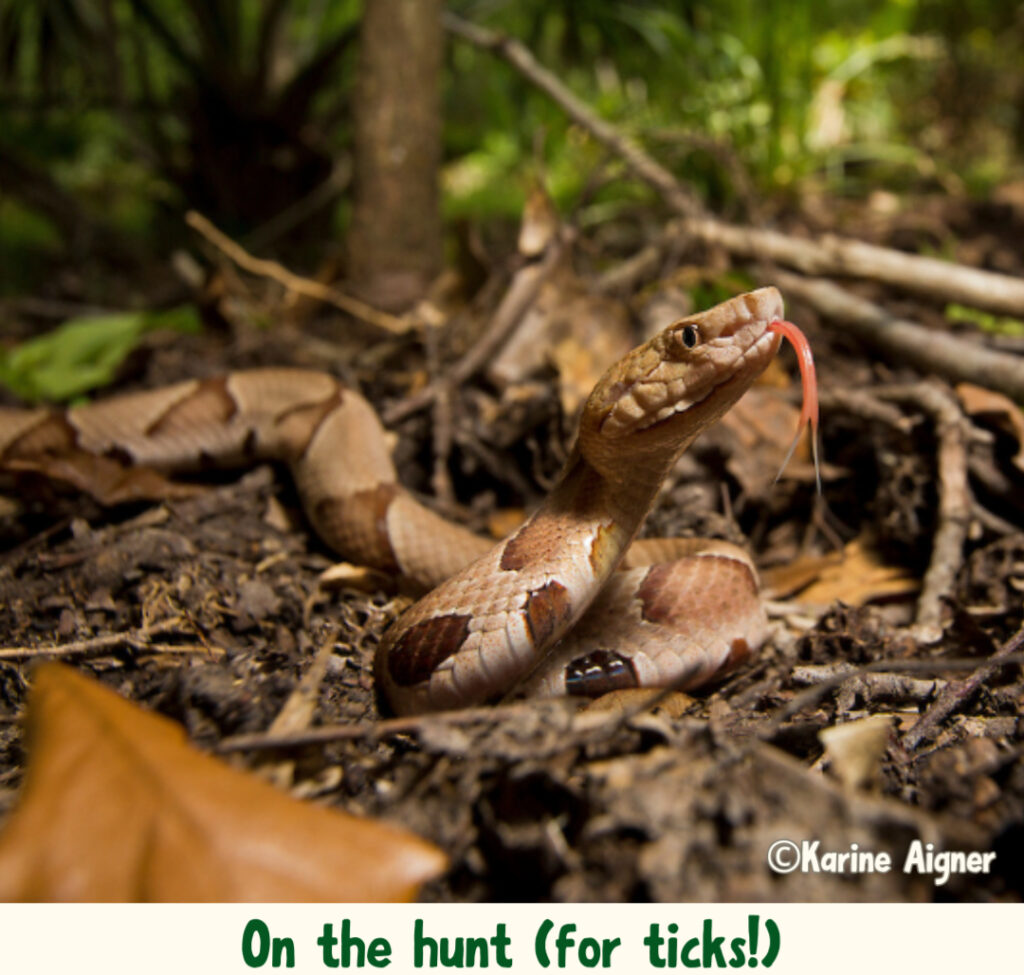
Snakes are clearly vital, and yet copperheads in particular face a poor reputation. Sadly, most of this reputation is grounded in myth! Let’s break a few of them down.
- “Young copperheads are more dangerous because they can’t control their venom.”
- FALSE. This myth is based on nothing yet is constantly repeated. Juvenile copperhead venom poses the same risk as an adult’s, and juveniles can control their venom the same.
- “Copperheads are deadly. If they don’t kill you, you’ll probably need an amputation.”
- FALSE. Copperhead venom rarely causes serious injury or death, even for children and pets. We often only hear of those rare cases in the news! In fact, the American College of Surgeons published a study of copperhead envenomations (bites) and found that “a bite by a copperhead (Agkistrodon contortrix) rarely requires any intervention other than observation.” Of course, that doesn’t mean you shouldn’t go to the doc. Go get checked out ASAP, but know you will be okay.
- “They’re just so aggressive.”
- FALSE. Wild animals, including copperhead snakes, are not aggressive inherently. What seems like aggression to us is actually defensiveness. When a copperhead is threatened, they have no other defense than their mouths. A bite is a last resort! If rattling their tail or freezing and hiding aren’t effective against an oncoming threat, like a person running after them with a shovel, they have no choice but to try and protect themselves. Hey, we’d probably bite too if it came down to it!
As Rockfish Wildlife Sanctuary is in a forested rural area, we often see copperhead snakes enjoying the landscape alongside us. We have never had anyone get bitten, though a few of us have nearly stepped on them. It just goes to show that, even at that last moment before we noticed them, they were still hoping we’d ignore them by remaining still. Copperheads have no interest in wasting their precious energy, let alone their venom, on a giant scary creature they know they can’t eat.
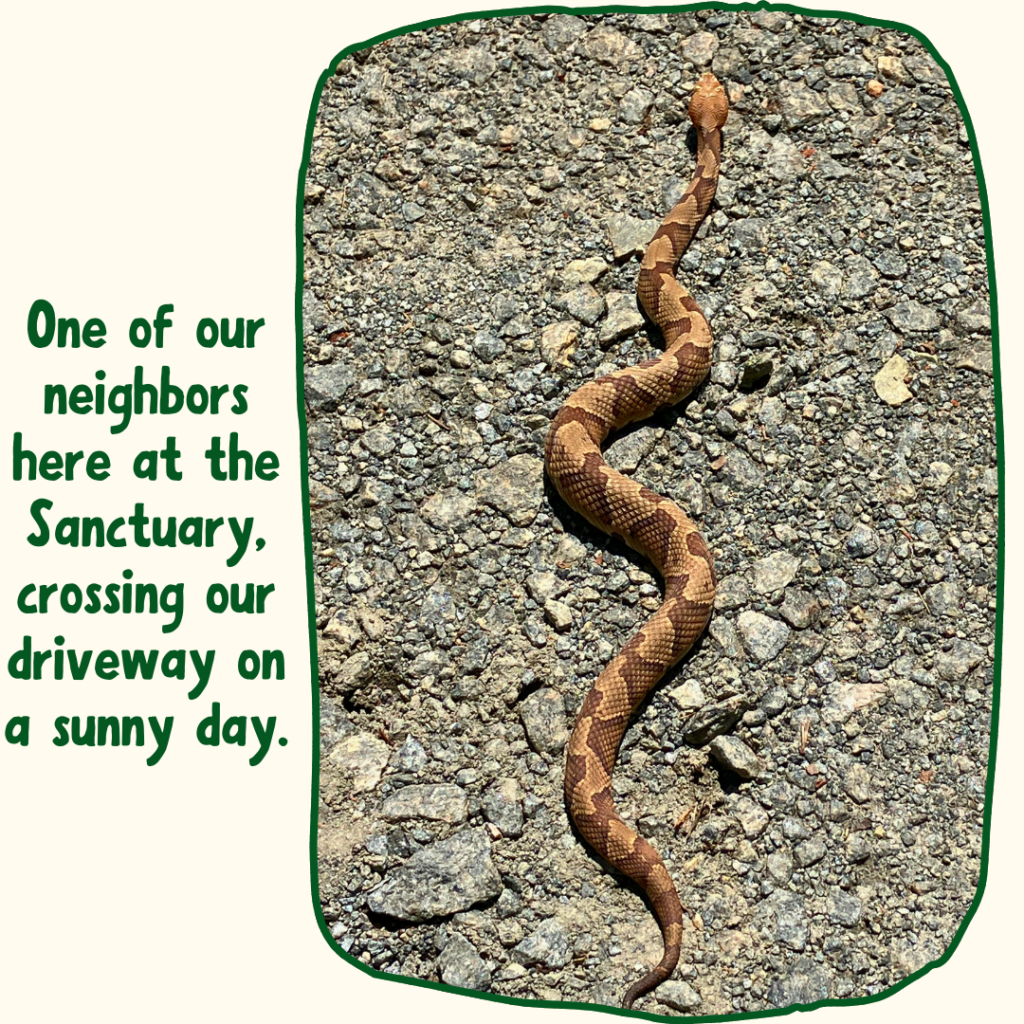
Now that we’ve busted some pesky myths, let’s talk about how we can coexist safely with these important, interesting creatures! Here are some effective tips:
- Keep your yard tidy. Snakes use hiding spots like brush piles, overturned toys, and sawdust or wood piles. If you are particularly nervous about copperheads, keeping your yard clear of debris can discourage snakes from hanging out.
- Teach children that snakes should be respected from afar, and not inspected up close. Help children learn snake identification so they feel confident in exploring the natural world.
- Wear shoes outdoors during the late spring and summer months. Bonus points if you rock above-the-ankle boots! Younger explorers can wear rainboots if they’re looking for easy slip-on shoes as they head outdoors.
- Before letting your pet or child out to run around, do a quick scan of the yard to look for snakes lounging about in the sun. Look over your patio, driveway, rock wall, or any other sunny warm zone. Monitor pets and kids as they’re outside, especially if you have seen snakes recently.
- Give snakes their space! Do not approach or handle a venomous snake, even if you really want to impress your hiking date. What’s more impressive? Respecting wildlife. 😎
- Remember that the presence of a snake does not mean danger. In Virginia, it is illegal to harm snakes unless they pose an immediate threat. Sadly, far too many people view a copperhead’s mere existence as a threat when, in reality, it is often the human who poses the threat.
Though they may still not be your favorite animals, snakes are valuable ecological stewards when it comes to maintaining a balanced, healthy environment. Treating copperheads with the respectful distance they deserve ensures a happy ending for everyone.
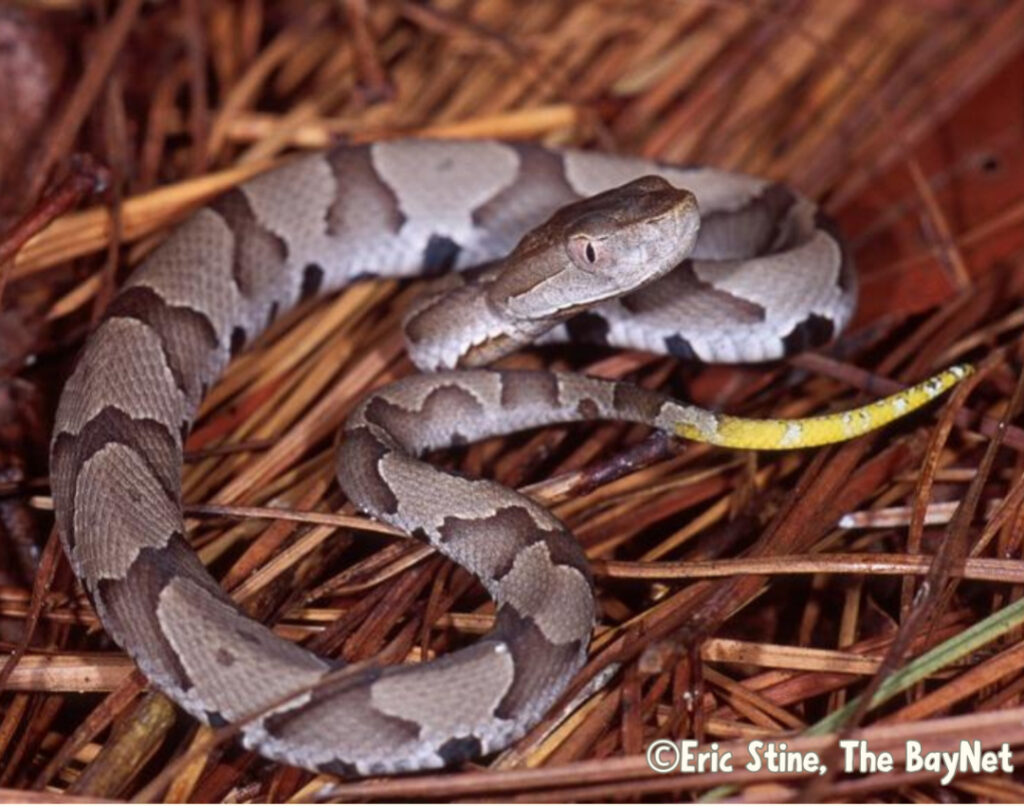
With these tips, we hope you feel more empowered to live as part of our natural world here in Virginia. Together, we can advocate against needless harm and create a friendlier world for all wild species.
June 29, 2024
Published:
Be the first to comment!